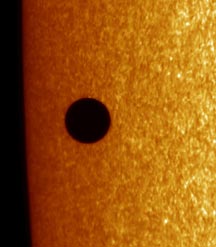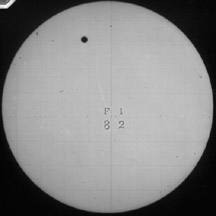
This illustration is original Windows to the Universe artwork created by Randy Russell. The image of the Sun is courtesy SOHO (ESA & NASA); information on the apparent size and path of Venus courtesy Fred Espenak, NASA's GSFC.
Venus Transit in June 2004
News story originally written on June 2, 2004
Sometimes planets go in between Earth and the Sun. When that happens astronomers call it a "transit". On June 8, 2004, the planet Venus will move between Earth and the Sun. There will be a transit of Venus!
A transit is a bit like an eclipse of the Sun. There hasn't been a transit of Venus in more than 100 years! The last one was in the year 1882.
Remember, it is never safe to look directly at the Sun. This NASA web site tells you how to safely watch the transit. It also has lots of good info about Venus transits.








